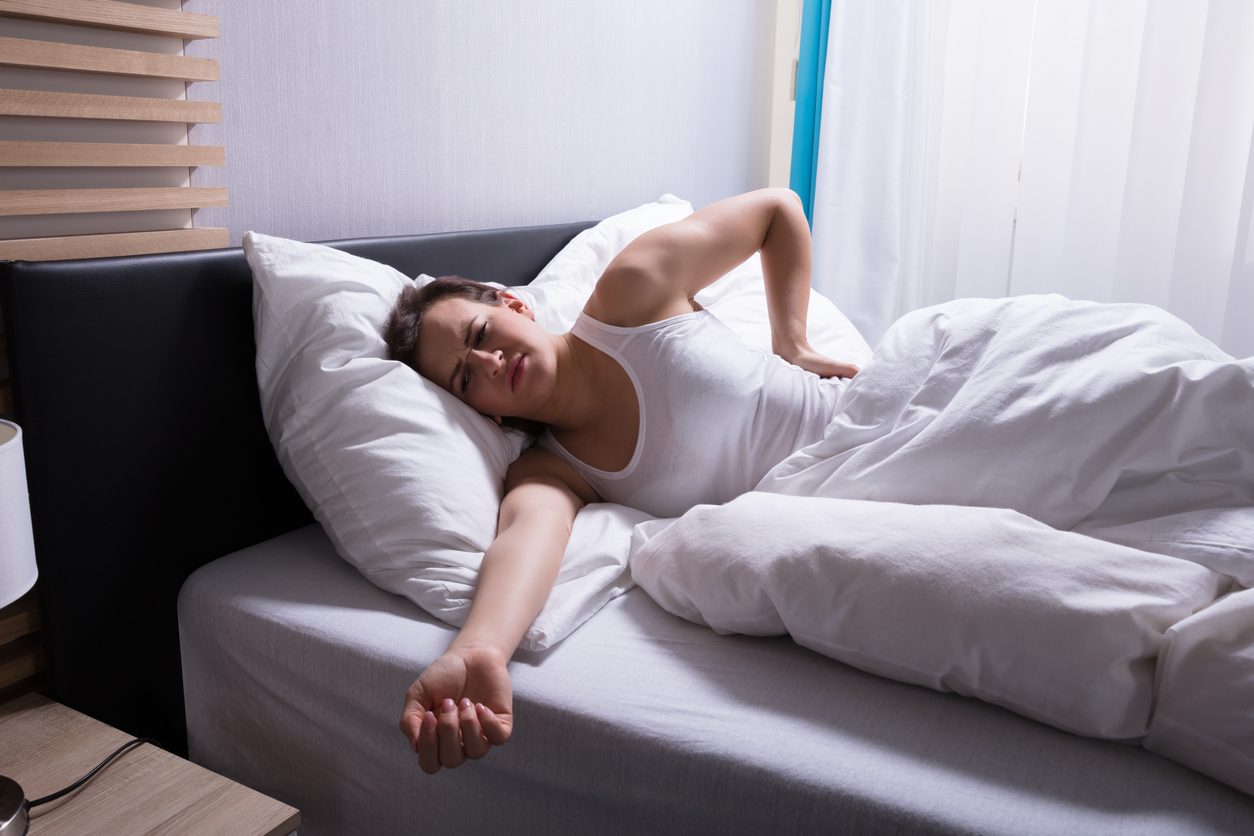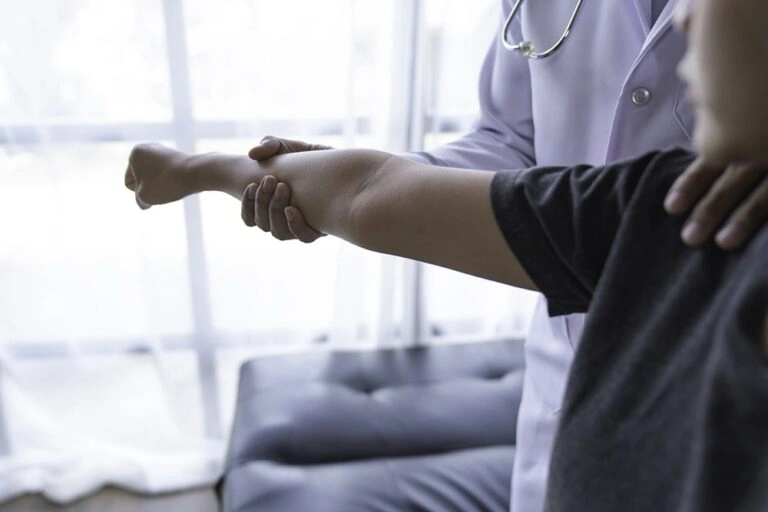Sleeping with a bulging disc can be tricky, especially since we’re creatures of habit. Unfortunately, sleeping in the wrong position (even if it’s your favorite position) can add stress to your spine, making the bulging disc worse, which can cause strange symptoms like digestive problems, numbness, and tingling. Not only does this keep you from getting a good night’s sleep, but it also prevents healing. And it can be pretty scary!
Luckily, no matter what position you like to sleep in, you can avoid making things worse.
Sleeping with a bulging disc is all about keeping your ears, shoulders, and hips aligned. This helps keep your spine aligned, which is the key to getting a good and healthy night’s rest. For back sleepers, this may mean putting a pillow under your knees. Side sleepers will want to use a pillow between the knees.
Read on for specifics to help you sleep with a bulging disc!
How to Sleep With a Bulging Disc in the Back or L4 L5?
Although you may not realize it, most back pain occurs in the lumbar or lower spine. So if you’re having low back pain, it’s likely in one of two places near where your spine meets your pelvis. In fact, it’s estimated that around 95% of low back herniations happen in the L4-L5 spinal segment or the L5-S1 Lumbosacral joint.
Since nearly 80% of the population will suffer from back pain at some point, you have lots of experience to pull from when it comes to sleeping with low back pain. And since studies show that back pain can start a vicious cycle of poor sleep, which leads to more pain, which leads to worse sleep, it’s important to find relief quickly.
Let’s take a look at the most tried-and-true positions for sleeping with a bulging disc.
Sleeping on Your Back
Back sleeping, when done right, is the best way to sleep for the health of your back — herniation or not. But, the important thing here is to make sure your entire back is supported when sleeping.
So if you have a gap between your mattress and your back, you’ll want to get a thin pillow or a towel to fill that gap, giving you the support your back needs.
Back sleepers can also benefit from a pillow or two under the knees, which elevates the legs and helps keep the natural curve of the pine. Some people find they need both the pillow or towel in the small of their back and the pillow or pillows under their knees.
Sleeping on Your Side
Side sleepers have a couple of options when it comes to sleeping with a bulging disc. You can try both to see which one gives you the best pain relief at night.
- Pulling your legs up toward your chest while sleeping on your side can provide relief from a bulging disc. This is called the fetal position and can be a good choice for some as it relieves the pressure on the discs in the low back. It’s best to try to switch sides if you do sleep in the fetal position to keep things even.
- A pillow between the knees while sleeping on your back is another good option. This helps to keep your hips aligned, which also helps keep your spine in its neutral position. This is especially helpful if you sleep on your side with your legs bent at a shallow angle, but it can also help when sleeping in the fetal position.
Stomach Sleepers
Generally, it’s best to try and avoid sleeping on your stomach, as it pulls the spine into an unnatural curve that can actually cause back pain. But if this is the only way you seem to find relief, you can put a pillow under your hips and lower abdomen to prevent that unnatural spinal position.
You’ll also want to pay attention to your neck, as there’s not a great way to keep your neck in a neutral position when sleeping on your stomach.
How to Sleep With a Bulging Disc in the Neck?
Sleeping positions for a bulging disc in your upper back or neck are similar to sleeping positions for one in your lower back. It’s all about supporting the spine while maintaining its natural curve. For the neck, this means a pillow that’s not too thin or too thick.
Just imagine you’re standing up straight with proper posture. This is how you want to sleep, so find a pillow that allows you to keep your neck in a neutral position. For back sleepers, this will be a thinner pillow. For side sleepers, a thicker one to keep the head from tilting down too much.
How to Sleep With Bulging Disc and Sciatica?
Sciatica is commonly caused by a bulging or herniated disc. So if you are suffering from sciatica and a bulging disc, you can simply try the sleeping positions listed above to see which one works best for you.
Taking the pressure off the bulging disc should also take the pressure off the sciatic nerve, which should give you relief and help you heal.
Tips for Sleeping with an L5 S1 Bulging Disc
Sleeping with an L5 S1 bulging disc requires careful attention to your sleeping posture and support, considering the specific location of this disc at the bottom of the lumbar spine. One effective way to alleviate pain and pressure on the disc is by sleeping on your back with a pillow placed beneath your knees. This position helps maintain the spine’s natural curvature and takes the strain off the lower back.
Different people may find other positions comfortable, such as sleeping on the side in a curled-up, fetal position. This position can help open up the space between the vertebrae and alleviate the pressure on the L5 S1 disc. If you choose this position, it’s recommended to place a pillow between your knees to maintain hip and spine alignment. Always remember that every individual might respond differently to these positions, so experimenting with various postures and noting which one eases your discomfort the most is crucial.
A high-quality, supportive mattress and pillow are equally important. Memory foam mattresses that contour to your body shape can provide the essential support your lower back needs. Similarly, a pillow that keeps your neck aligned with the rest of your spine can prevent worsening the condition. A healthcare professional or chiropractor can provide personalized advice based on your specific symptoms and condition.
Your Sleeping Position is Only Part of the Story
While sleeping with a herniated disc may be your primary concern right now, it’s far from all you need to do if you want to get back to normal. Studies show that sleeping position can provide relief at night, helping you sleep. But the position you take depends largely on the location of the bulging disc, its severity, and what’s causing it.
A chiropractor can help you find the best sleeping position for your bulging disc. He or she can also help you determine what’s causing it, help relieve the pain associated with it, and make sure you experience long-term relief without recurrence. Click the following link for more information on how a chiropractor treats a bulging disc.
Sleep Techniques for a Herniated Disc: Practical Approaches
To alleviate the discomfort associated with a herniated disc during sleep, various techniques can be implemented. The first is the use of appropriate sleep aids. For instance, investing in a high-quality, orthopedic mattress can provide the necessary support for the spine’s natural alignment. Similarly, ergonomic pillows that conform to the neck and head’s contours can reduce the strain on the neck and upper spine, promoting better sleep.
Secondly, sleep hygiene practices can significantly impact sleep quality. This includes maintaining consistent sleep and wake times, avoiding caffeine and stimulating activities close to bedtime, and creating a sleep-friendly environment (dark, quiet, and cool).
Lastly, regular physical therapy and exercises designed for herniated discs can also improve sleep. Exercises that stretch and strengthen the back can help alleviate the pressure on the herniated disc and enhance overall spine health. It’s important to consult with a healthcare professional or physical therapist to get a personalized treatment plan.
Resources:
https://www.ncbi.nlm.nih.gov/books/NBK560878/
https://link.springer.com/article/10.1007/s00586-008-0660-7
https://content.iospress.com/articles/work/wor2243









